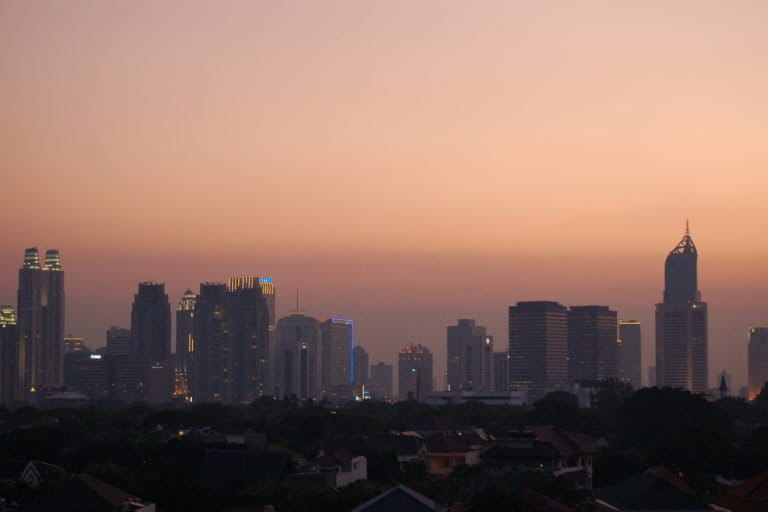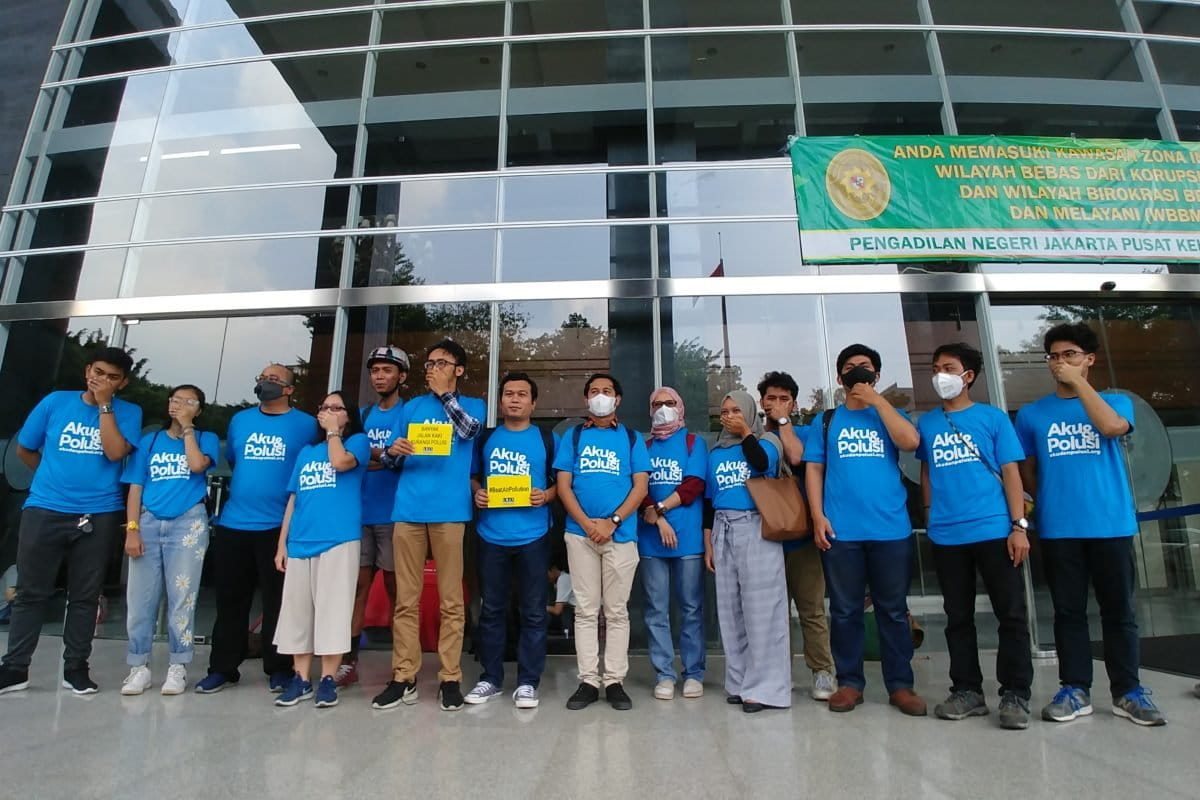- A group of citizens is suing the Indonesian government, including the president, over the poor air quality in Jakarta, which in recent weeks has ranked as the worst in the world.
- The plaintiffs say the government has failed to take meaningful action to address the many sources of air pollution, and want it to update its safe threshold for pollutant exposure to be in line with global standards.
- The government, however, has deflected, claiming variously that the air quality data is inaccurate, that the public is to blame for not taking mass transit, and that the problem isn’t as severe as it’s made out to be.
- While studies show vehicle emissions account for up to 70 percent of Jakarta’s air pollution, the number of days per year with unhealthy air has actually doubled since an award-winning improvement of the public transit system, indicating other sources play a greater role.
JAKARTA — Ni Komang Ayu Leona Wirawan left her hometown of Klungkung, on the island of Bali, for Jakarta on neighboring Java three years ago to attend law school.
The contrast between the two places couldn’t be greater: one is a farming and fishing district of 180,000 people; the other, a sprawling, chaotic conurbation of more than 30 million, one of the biggest in the world.
While a metropolis like Jakarta offers abundant opportunities for an enterprising 21-year-old like Leona, it can’t give her the most fundamental thing of all: clean air.
“Sometimes I don’t want to go out of the house because of the dirty air,” Leona tells Mongabay. “Sometimes I miss my home in Bali.”
Jakarta currently has some of the world’s filthiest air. In the past few weeks, it ranked repeatedly as the world’s most polluted city, with levels of PM2.5, a fine particulate matter deemed harmful to human health, reaching “unhealthy” concentrations.
Fed up with the worsening pollution, Leona joined a group of 30 other residents from a wide range of backgrounds to file a citizen lawsuit against the Indonesian government for failing to address public concerns over the poor air quality in the capital.
The lawsuit, filed July 4 by the group calling itself the Jakarta Advocacy Team, holds seven top government officials liable for the problem, including President Joko Widodo and Jakarta Governor Anies Baswedan. The group had long sought to bring attention to the air pollution problem, warning during a protest last December that they would file suit if their demands went unheeded.
“These seven officials, in our view, have ignored the rights of Jakarta citizens and Indonesian citizens who live and work in Jakarta to breath healthy air,” Nelson Nikodemus, a lawyer at the Jakarta Legal Aid Institute (LBH Jakarta), which is part of the Jakarta Advocacy Team, told reporters at the court.
Among their demands, the activists want a comprehensive research-based plan to reduce air pollution, similar to what the Chinese government did in 2014 when it declared war on air pollution and unveiled an action plan to improve overall air quality across the country within five years.

Denials and deflections
Official responses to the citizen lawsuit have been varied. The Ministry of Environment and Forestry, for instance, said the activists were within their rights to do so, but questioned the air quality data they presented in their suit.
“Of course we will provide answers on what we’ve done” to reduce air pollution, M.S. Karliansyah, the ministry’s head of environmental degradation mitigation and control, said at a press conference. “I’m worried that the data [used] is only temporary data, not an average.”
Governor Anies, for his part, has sought to shift the blame to the public, including the activists, for not using public transportation often enough.
“Those people filing the lawsuit have also contributed to the air quality decline. Unless everyone rides a bicycle, it would be different if that’s the case,” he said as quoted by tempo.co.
“The air quality is not only caused by one or two professions, but by all of us, including those that filed the civil lawsuit,” he added.
Andono Warih, who heads Jakarta’s environmental agency, also questioned the data used by the activists, taken from the air-quality monitoring app AirVisual, saying it was not accurate and that conditions were “not that bad.” He said the app used for its rankings the U.S. Environmental Protection Agency’s Air Quality Index (AQI), which he claimed made the air pollution in Jakarta seem worse than it was.
AirVisual collects its data from various sources, including the U.S. Embassy’s air quality monitors, the Indonesian meteorological agency (BMKG), and Greenpeace Indonesia.
Karliansyah, the environment ministry official, said the three devices used by Greenpeace Indonesia weren’t accurate because they were portable and used primarily for measuring indoor air pollution.
“We’ve studied [the accuracy of the device] and they can’t differentiate between dust particles and water particles, which is why the readings [of PM2.5] are high,” he said.
Greeenpeace Indonesia climate and energy campaigner Bondan Andriyanu said the NGO was no longer using those devices, and had replaced them with the AirVisual Pro, which has been certified for both indoor and outdoor air quality monitoring, with high accuracy for measuring PM2.5 levels.
“These devices are used all around the world,” he said. “To date, there’s not a single government around the world that questions [the accuracy of] the device.
“This is not the time to debate the methodology and the devices,” he added. “What’s clear is that the air pollution in Jakarta is already severe and we need to do something about it.”
Bondan said the ministry’s own data also showed worsening air quality in Jakarta. There were 196 days last year when the air was deemed unhealthy for certain sensitive groups, such as pregnant women and children, according to the official data.
“But there’s been no action from the government,” Bondan said. “The least they could do is to announce it [in real time], but why wait until 2019 to announce” that the air quality was unhealthy for more than half the year in 2018.

Lax, outdated standards
Bondan said the ministry’s own data should also be subject to scrutiny, given that the ministry operates just one monitoring station in the capital, installed last year in a sports complex that’s one of the few green areas in the city. He said there needed to be at least 26 such stations peppered throughout Jakarta to give an accurate representation of air quality across the city.
Karliansyah countered that the monitoring station could measure air pollution within a radius of 5 kilometers (3 miles). He added the ministry wanted to install more stations, but the cost was prohibitive.
Andono, from the city environmental agency, said his office would soon install 10 new monitoring stations to measure PM2.5 levels throughout the capital, at a cost of 5 billion rupiah ($354,000) each. The city currently operates five such stations, but they’re only capable of measuring the much larger PM10 particles. They also lack a real-time monitoring feature.
Bondan said the government’s insistence that air pollution was under control was misleading. He said the national standard for what constituted an unhealthy concentration of PM2.5 was much more lax than elsewhere in Asia or as recommended by the World Health Organization. The latter’s safe threshold for PM2.5 exposure in a 24-hour period is 25 micrograms per cubic meter; Indonesia’s threshold is nearly three times higher, at 65 micrograms per cubic meter.
Bondan noted that the Indonesian threshold was determined in 1999 and needed to be updated.
“Even if there are plenty of air monitoring devices, if we still use the old standard, which is weak, then the government can say that the air pollution is still mild,” he said. “Even when people are having trouble breathing.”
He cited the case of Jambi province on the island of Sumatra, which was blanketed with thick smog from forest fires earlier this year.
“The fires were raging hard and thousands of people suffered respiratory problems, and yet the monitoring stations still recorded the air pollution as mild,” Bondan said. “It’s a proof that the current monitoring stations have weak standards and aren’t capable of protecting the public from air pollution.”
Karliansyah said the environment ministry had planned to make the PM2.5 safe threshold stricter to 35 micrograms per cubic meter by revising the 1999 standard.

Various sources of pollution
Leona, the law student filing suit over the pollution, says she’s frustrated with the government’s constant denials about the severity of the problem.
“I want this lawsuit to be followed up because even now, the government continues to be stubborn when it comes to air pollution, choosing not to believe the data or the methodology,” she says. “They’re stubborn and yet they do nothing. I really want to see action, either switching to gas- or electric-based vehicles, or subsidies for environmentally friendly transportation so that people will want to switch.”
The plaintiffs are also demanding the government systematically investigate and address all sources of air pollution. Vehicle emissions account for up to 70 percent of the pollution, Karliansyah said, citing a 2013 study carried out by the government and the United Nations Environment Programme (UNEP).
But a 2016 study by the NGO Committee to Phase Out Leaded Fuel (KPBB) says that vehicles account for 47 percent of the air pollution in the capital. It ranks emissions from factories next, at 22 percent, followed by road dust and households (11 percent each), waste incineration (5 percent) and construction work (4 percent).
Burning of coal is also a factor, said Agung Pujo Winarko, the head of pollution mitigation at the city environmental agency.
“The two power plants in Jakarta use gas,” he told Mongabay, adding that “coal is still used in some industrial activities in Jakarta.”
Lauri Myllyvirta, senior global campaigner for coal and air pollution at Greenpeace, said much of Jakarta’s air pollution originates from outside the city, including from factories, coal-fired power plants, and vehicles.
Bondan said addressing vehicle-based pollution wouldn’t be enough. He noted that even after Jakarta’s notorious gridlock had been reduced, with the city winning an award for its much-improved public transportation system, the air pollution problem only got worse.
“The number of unhealthy days in 2018 was actually double that in 2017,” he said, citing data from the U.S. Embassy’s two monitoring stations. “So as our transportation system improved, the number of unhealthy days actually doubled. That’s the fact and that’s a form of negligence [on the part of the government] because the policies they’ve adopted aren’t based on data or a clear roadmap.”
Khalisah Khalid, a spokeswoman for the Indonesian Forum for the Environment (Walhi), said she hoped the citizen lawsuit would jolt the government into action. She said her daughter, Jingga, was particularly sensitive to air pollution, suffering frequent nosebleeds as a result.
“There are a lot of children like Jingga who are very vulnerable from any change in air quality,” Khalisah said. “Imagine if she has to go to school every day inhaling dirty air, which is dangerous for her health. I’m worried about the health of my daughter and other children who are exposed [to air pollution].”
Banner image: A group of Jakarta citizens file a citizen lawsuit against the Indonesian government on July 4. Image by Hans Nicholas Jong/Mongabay.
FEEDBACK: Use this form to send a message to the author of this post. If you want to post a public comment, you can do that at the bottom of the page.
